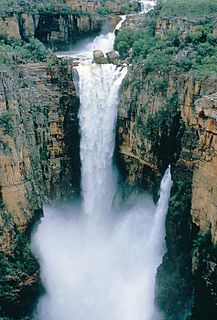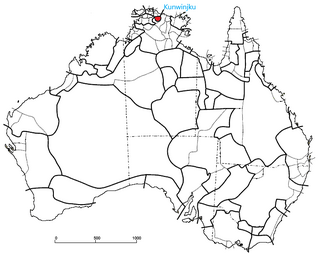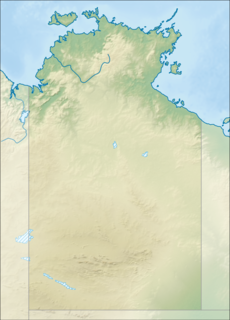In Australian Aboriginal mythology, Mamaragan or Namarrkon is a lightning god who speaks with thunder as his voice. He rides a storm-cloud and throws lightning bolts to humans and trees. He lives in a puddle.
Terminalia ferdinandiana, also called the gubinge, billygoat plum, Kakadu plum, green plum, salty plum, murunga or mador, is a flowering plant in the family Combretaceae, native to Australia, widespread throughout the tropical woodlands from northwestern Australia to eastern Arnhem Land. It has a high concentration of vitamin C in its fruit: recorded concentrations of 2300–3150 mg/100 g wet weight and occasionally as high as 5300 mg/100 g, compared with 50 mg/100 g for oranges, ranks among the highest known of any natural source.

Gunbalanya is an Aboriginal Australian town in west Arnhem Land in the Northern Territory of Australia, about 300 kilometres (190 mi) east of Darwin. The main language spoken in the community is Kunwinjku. At the 2016 Australian census, Gunbalanya had a population of 1,116.

The Iwaidjan or Yiwaidjan languages are a small family of non-Pama–Nyungan Australian Aboriginal languages spoken in the Cobourg Peninsula region of Western Arnhem Land.
Bininj Gun-Wok is an Australian Aboriginal language group which includes six dialects: Kunwinjku, Kuninjku, Kundjeyhmi, Manyallaluk Mayali (Mayali), Kundedjnjenghmi, and two varieties of Kune. Kunwinjku is the dominant dialect, and also sometimes used to refer to the group.
Ngardi, also spelt Ngarti or Ngardilj, is an Australian Aboriginal language that is considered moribund. It was previously thought to be an alternative name for the Bunara language, but these are now classified as separate languages. It was/is spoken by the Ngarti people of the Northern Territory and northern Western Australia.

Acrochordus arafurae is an aquatic snake species found in northern Australia and New Guinea. No subspecies are currently recognized.

The black wallaroo, also known as Bernard's wallaroo or Woodward's wallaroo, is a species of macropod restricted to a small, mountainous area in Arnhem Land, Northern Territory, Australia, between South Alligator River and Nabarlek. It classified as near threatened, mostly due to its limited distribution. A large proportion of the range is protected by Kakadu National Park.

The short-eared rock-wallaby is a species of rock-wallaby found in northern Australia, in the northernmost parts of the Northern Territory and Western Australia. It is much larger than its three closest relatives, the eastern short-eared rock-wallaby, the nabarlek and the monjon.

The Jim Jim Falls is a plunge waterfall on the Jim Jim Creek that descends over the Arnhem Land escarpment within the UNESCO World Heritage–listed Kakadu National Park in the Northern Territory of Australia. The Jim Jim Falls area is registered on the Australian National Heritage List.

The Gunwinggu (Kunwinjku) people are an Australian Aboriginal people, one of several groups within the Bininj people, who live around West Arnhem Land to the east of Darwin, Northern Territory. Kunwinjku people generally refer to themselves as "Bininj" in much the same way that Yolŋu people refer to themselves as "Yolŋu".
Maung is an Australian aboriginal language spoken by the Maung people on the Goulburn Islands, off the north coast of Arnhem Land, in the Northern Territory of Australia. Maung is closely related to Iwaidja language which occupies the northwestern corner of the opposite mainland. This is a language that belongs to the Iwaidjan language family of Non-Pama–Nyungan languages. As of 2016, there were 370 speakers of the language.
Gunbarlang, or Kunbarlang, is an Australian Aboriginal language in northern Australia with multiple dialects. Other names are Gungalang and Warlang. Speakers are multilingual in Kunwinjku and Mawng. Most of the Gunbarlang people now speak Kunwinjku.

Livistona humilis, the sand palm, is an Australian plant species of the family Arecaceae. It is a small, slender palm, growing to about 7 m tall and 5–8 cm dbh. It has 8 to 15 fan-shaped leaves, 30–50 cm long with petioles 40–70 cm long. It is endemic to the Top End of the Northern Territory in Australia. Genetic investigation suggests that its closest relation is Livistona inermis. This palm is fire tolerant and usually grows in environments where it is exposed to frequent fires.

The Goomadeer River is a river in the Northern Territory, Australia.
The Bininj are an Aboriginal Australian people of Western Arnhem land in the Northern Territory. The sub-groups of Bininj are sometimes referred to by the various language dialects spoken in the region, that is, the group of dialects known as Bininj Gun-Wok; so the people may be named Gunwinggu, the Kuninjku, Kundjeyhmi (Gundjeihmi), Manyallaluk Mayali, Kundedjnjenghmi and Kune groups. In addition, there are clan groups such as the Mirrar who are prominent in matters relating to looking after the traditional lands.

The Gaari were an indigenous Australian people of the Northern territory, who lived on a small island in the Arafura Sea.
The Dalabon or Dangbon are an Australian Aboriginal people of the Northern Territory.
The Yangkaal, also spelt Yanggal, are an Aboriginal Australian people of area of the Gulf of Carpentaria in the state of Queensland.

Mondalmi was an Aboriginal activist and cultural informant from Australia.